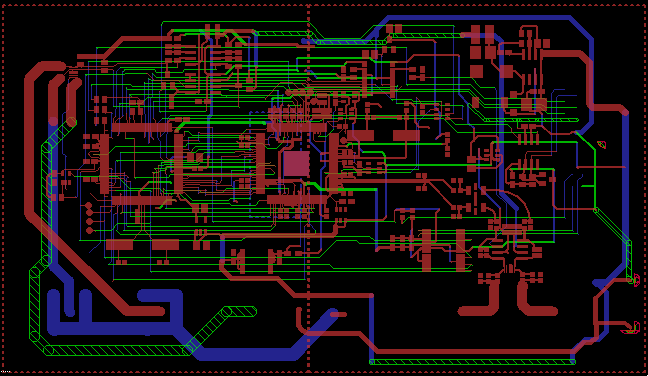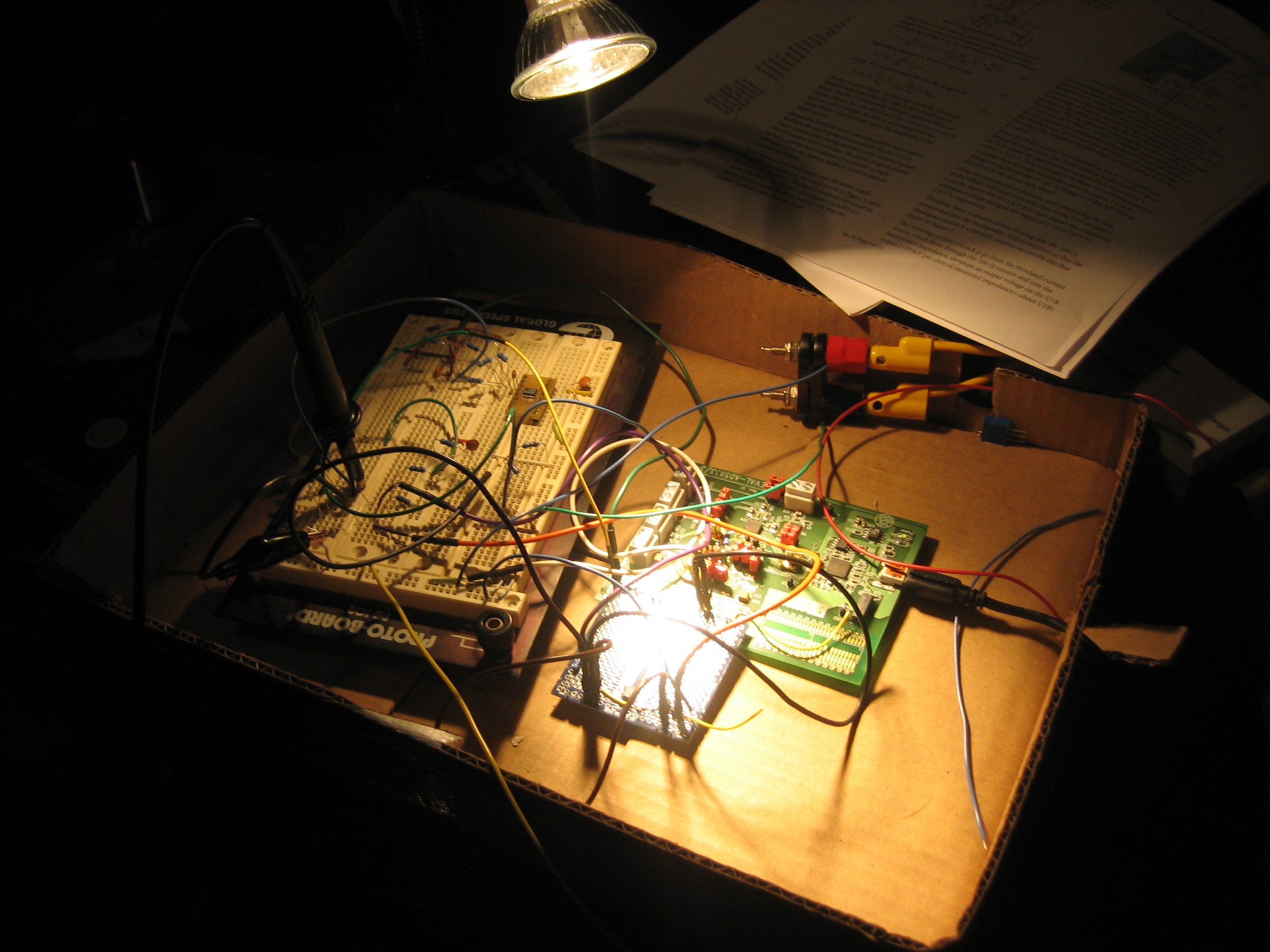note: redacted stuff as requested by lawyers
Got the boards in for the BlackCloud project
[REDACTED IMAGE]
We had 2 of 25 pre-assembled for testing. Good thing too. Some components were not populated, a connector was put on the wrong side, and all 25 LEDs on the top of one of the PCBs were placed backwards. Used PCBFABEXPRSS for the first time for assembly. They seem desperate for bussiness, so they probably woun’t last. Too bad they can’t focus on the details.
Electronics
blackcloud
Any guesses what this is?

Electronics

I’ve just finished the second week of human trials, and I’ve already learned a lot about device usability and some weaknesses which I want to incorporate into a newer version of the chest strap. The data is quite fun to go through, and it looks better than I expected for an ambulatory device. Here’s an excerpt from one of our subjects..

Electronics, HealthMonitor
It was a few years in the works, but the time is finally here — time to collect some real data from random test subjects. We’re going to be collecting SpO2, ECG, EMG, BioImpedence (respiration), and 3-axis accelerometry at 256Hz. The firmware seems fairly solid, and the signals all look really good.

Tricorder and related hardware
By friday, we should have 24 hours worth of nice, clean, data. Else, I’m going to have a busy haloween weekend.
Electronics, HealthMonitor
human trials, tricorder
After dealing with a few ugly hurdles (mostly having to do with a horrible new serial module in the MSP430F2618), life is starting to look really good. The filesystem is working very nicley with a shared serial bus with the accelerometer (SPI) and the bioImpedence circuit (AD5933 impedence measurement IC; I2C). See how nicely they play together..


And even the SpO2 signal is finally looking really /really/ nice..

Though that data is from a transmissive sensor. We’re still investigating the efficacy of an upper arm reflective sensor, but I’m quite pleased given the complexity of the new device.
Electronics, HealthMonitor
i2c, serial, spi, spo2
I want to interface into my Ademco alarm system, and the easiest way to do it is to intercept serial commands from the RF recieve module to the main unit. Here’s what a waveform looks like..
From the looks of it, the duration of each packet is the same, so each bit should represent the same unit of time. The first three transitions are the same for all packets, and the third transition is 2.5 bits long, so I would assume that’s a preable. The rest of the data are in multiples of 420us. I wrote a script to decode packets, and here’s a dump of a random capture. Each line represents one message, like the one above…
1000000001001010111010001111110110001110101010001101101010001
1000000001001000011010001010101011001101111011001110011010001
1111110110001111111111001101111110001111011110001111111111111
1100000000001110111000001011011010001001101011001011111011001
1000000001001101101010001010011011001010111010001110111011001
1000000001001010010111001111101011001101100011001010110011001
1000000001001001100010001001100010001111110110001101010110001
1000000001001111110110001100111010001011011010001101101010001
1000000001001010111010001111110110001110101010001101101010001
1000000001001000011010001010101011001101111011001110011010001
Next I get to try to find some sort of pattern to the above mess, and hopefully the data is not encrypted — which I doubt it would be.. If anyone has any ideas, please let me know!
Electronics
ademco, alarm, hacking, serial protocol
It took a solid 25+ hours of work, but I finally got the MSP430F2618 to talk to the AD5933 via I2C. The TIs documentation sucks, their module sucks, and I’m angry. But it works now. A hit to those that might be stuck: The USCIABxTX_ISR() interrupt vector should be called the Master interrupt vector, and their USCIABxRX_ISR() interrupt vector should be the Slave interrupt vector. In master mode, both the TX and RX interrupt enables results in the TX_ISR() vector being called.
Other issues include that the SDA line gets stuck latched low and will persist through a power cycle and a reprogramming. You expicitley have to pull the line high in software to reset it.
A bunch of other issues later, I got it working.. I ended up picking up a new logic analyzer because of it’s improved interface than my USBee unit. $150, and it ROCKS. Joe makes them locally, and I recommend you pick one up for your toolbox.

data read from ad5933
Electronics
logic analyer i2c msp430 ad5933
 I’ve finally reached a point where 50% of my pulled shots no longer suck, so I thought I would go ahead with the PID conversion for my espresso machine. I actually had everything for the conversion in my office, except for the enclosure which I picked up from Newark for $18 (Hammond enclosure).
I’ve finally reached a point where 50% of my pulled shots no longer suck, so I thought I would go ahead with the PID conversion for my espresso machine. I actually had everything for the conversion in my office, except for the enclosure which I picked up from Newark for $18 (Hammond enclosure).
I followed the steps from http://www.murphyslawonline.com/silvia.html for the most part, and also found http://www.gumbrell.com/archives/2005/02/pidd-silvia-uk.html useful.
The deviations were mostly with regards to the thermocouple mount. I had a bare bone thermocouple, put a gob of thermal conductive paste on it, and stuck it underneath one of the screws on the boiler. It seems to work OK.
I used velcro to mount the enclosure, but it doesn’t look very stable, so I’m going to have to figure out something else. Otherwise, we shall see how it influences my shots.
More photos here.
Electronics, Personal
 Stephan from VG Bio came over for a visit and we spent the day debugging the BioImpedence circuit based on the AD5933 IC. It consists of a voltage to current converter, a differential amplifier, and the AD5933 IC (as well as a number of passives). Using the development software, we were able to graphically visualize Stephan’s breathing. Pretty cool.
Stephan from VG Bio came over for a visit and we spent the day debugging the BioImpedence circuit based on the AD5933 IC. It consists of a voltage to current converter, a differential amplifier, and the AD5933 IC (as well as a number of passives). Using the development software, we were able to graphically visualize Stephan’s breathing. Pretty cool.
Look here for more photos.
Electronics, HealthMonitor
I’m very excited; the latest version of the Berkeley Tricorder has been assembled, and is en route back here. I’m expecting to get them in early next week. Yay!


Electronics, HealthMonitor










 Stephan from VG Bio came over for a visit and we spent the day debugging the BioImpedence circuit based on the AD5933 IC. It consists of a voltage to current converter, a differential amplifier, and the AD5933 IC (as well as a number of passives). Using the development software, we were able to graphically visualize Stephan’s breathing. Pretty cool.
Stephan from VG Bio came over for a visit and we spent the day debugging the BioImpedence circuit based on the AD5933 IC. It consists of a voltage to current converter, a differential amplifier, and the AD5933 IC (as well as a number of passives). Using the development software, we were able to graphically visualize Stephan’s breathing. Pretty cool.
